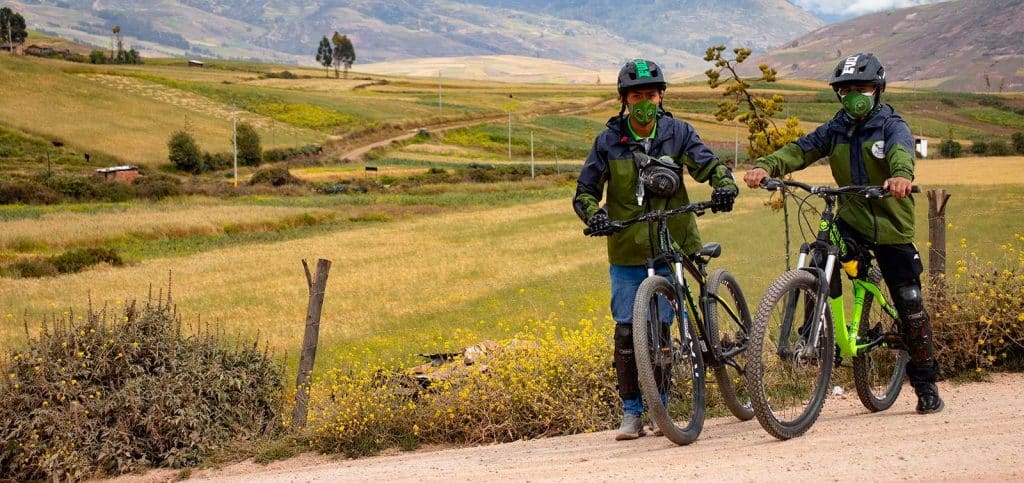
1/2 Day
Easy
3800 msnm.
Bicycle Tours, Adventure Tours.
From 02 - 10 people
Price per person in group service
Pay to:
Bicycle Tour South Valley route Laguna Huacarpay Piquillacta 1/2 day, a different way to carry out tours in Cusco and the archaeological parks of the South Valley, the most important archaeological parks that surround Cusco, we can do in about 4 hours approximately where we will tour the valley of the Cusco, with tourist attractions that highlight this place.
LEARN MORE ABOUT MOUNTAIN BIKING TOUR SOUTH VALLEY CUSCO
Our South Valley Bicycle Tour. Larapa-Saylla-Oropesa-Laguna Huacarpay-Piquillacta, also known as Biking Valle Sur, is located between the districts of San Jerónimo, Saylla, Oropesa, and Lucre, which are located at 3,200 m.a.s.l., where we can visit the Archaeological Park of Tipon, Piquillacta, and the Huacarpay Lagoon, as well as the Huasao Wetlands.
WHAT PLACES CAN YOU FIND ON THE SOUTH VALLEY CYCLING TOUR ?
Within the visit that we will make to the South Valley, we will have the option of visiting 2 important archaeological centers, which are Tipon and Piquillacta.
TIPON ARCHAEOLOGICAL CENTER
Today, Tipon is famous for its irrigation system that is still serving agriculture. Furthermore, it has a large, impressive growing space containing 12 terraces. This archaeological center is located 25 minutes from the main road. To visit it, you must go by car.
THE ARCHAEOLOGICAL CENTER OF PIQUILLACTA
Nowadays, It is famous for being the first urban center to correspond to the development time of the Wari empire. also well-knownCurrently, it has more than a thousand constructions between squares, colcas (food deposits), courts, houses, and temples.
We will arrive near this archaeological center on our bicycles and then optionally have a guided tour of Piquillacta.
To enjoy these attractions, we will use bicycles through the South Valley. Optionally, we can visit the Archaeological Park of Tipon and Piquillacta.
ARRIVING IN CUSCO.
Cusco has an airport for local or national flights. In order to get to Cusco, all travelers must disembark in Lima and go through migration, even if their flight to Cusco is on the same day and with the same airline.
WHICH ROUTE SHOULD I TAKE, BY AIR OR BY LAND?
The best travel option to Cusco is by air. Currently, there are several airlines that provide the Lima-Cusco air transportation service, among which we can mention: LATAM, VIVA AIR, SKY AIRLINE, and STAR PERU. Of all of them, LATAM is the most recommended, due to the variety of schedules it handles.
The land travel option is also a good option, but you always have to look for the best options that offer adequate comfort for the trip. The trip by bus is 22 hours. If your trip is from Puno or Arequipa, you can take this option since the trip is usually cheaper and it is only about 12 hours of travel.
DEPOSIT FOR LUGGAGE.
To be able to travel on domestic flights, you have to take into account the type of service contracted since there are rates where you can only get a maximum of 8 kilos of luggage. If you travel with more, make sure to hire it in advance and avoid setbacks when boarding.
If you have luggage, it can be left safely in the accommodation, or we can also provide you with a place of deposit at the Andino Tours Peru offices, but take into account the opening and closing hours of the office.
If you arrive before the Check In Time at the hotel, you can leave it totally free in the hotel deposit to be able to go out to carry out your activities or rest in the hotel lobby.
CUSCO HAS THE HIGHEST AVERAGE ELEVATION IN THE WORLD.
That is why people who travel at a lower level suffer from altitude sickness, “Soroche”. This is because at higher altitudes, less oxygen is contained than those who are at sea level, so the body works harder to get the oxygen it needs. That is why for long walks it is recommended to stay at least two days in Cusco.
Symptoms of altitude sickness are headache, tiredness, nausea, vomiting, sleep problems, loss of appetite, trouble breathing. Most of the time, the symptoms will be mild, but if they get worse, consult a doctor or contact our offices.
Coca tea is a recommended infusion for this disease, so within the accommodation it is always offered to counteract altitude sickness.
You must remember that you come to enjoy a trip through wonderful trails with people who will always be willing to help you, so you can relax and enjoy every moment.
THE WEATHER IN CUSCO.
One of the big questions is how the weather is in Cusco. It is easy to get this information on the internet, but you also have to take into account that each season and during these times the climates are changing. The dry season in Cusco is from April to October, but there will always be a sudden rain with lightning and thunder.
It is always advisable to have the appropriate rain gear, such as rain ponchos or waterproof jackets, waterproof gloves, and suitable shoes that do not slip in the rain.
FIRST AID.
Each member of the Andino Tours Peru staff has received first aid training from a specialist doctor. Every year we carry out this mandatory training, and on each of our excursions you will have a first-aid kit for basic medical problems (Traveler’s Diarrhea, scrapes, cuts, etc.) and, in fact, oxygen should not be lacking.
TRAVEL INSURANCE.
To protect your trip, the purchase of travel insurance is recommended. Having insurance before the trip is highly recommended. I have agreements with companies that provide this service that will make your trip more pleasant and peaceful in Peru.
ENVIRONMENTAL IMPACT.
For all our excursions, we have biodegradable soap, and all our garbage is returned to Cusco. Our staff is trained to take care of the environment. We use environmentally friendly chemical portable toilets.
We launched a program where for each traveler who reserves with us, we donate 10 trees that will be delivered to the communities of Mikaypata, Ninamarca, Huatoqto, and others, committing them to caring for the environment.







Save up to 20% on tours! Get exclusive access to members-only offers by email.
Developed by Cusco Technology

Select the type of service (Group or private service) and the number of passengers.